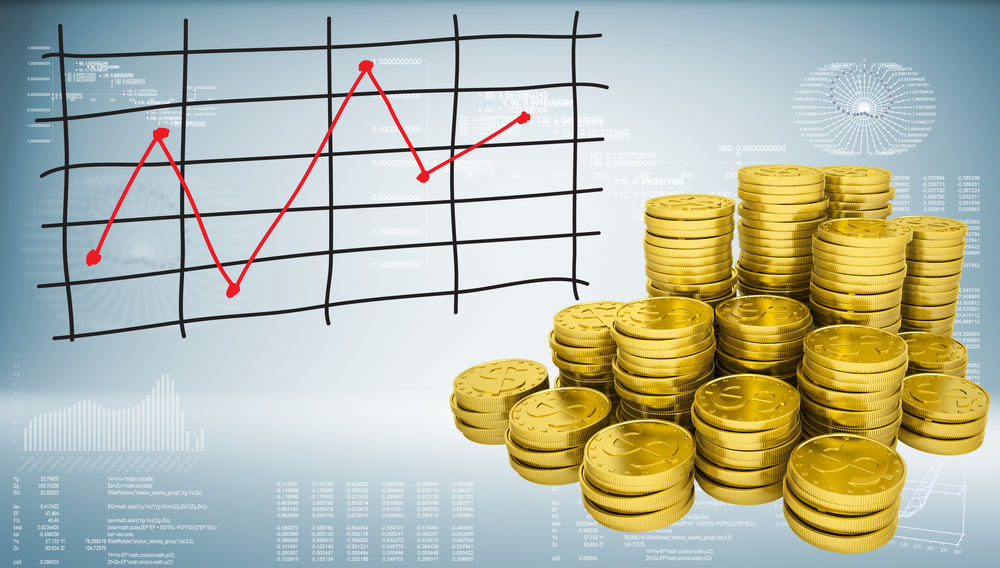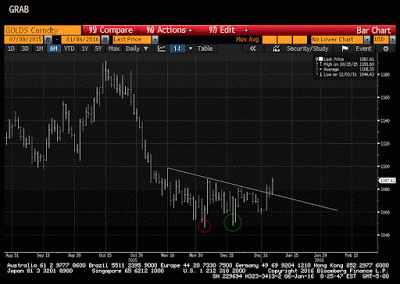Could Gold be Forming a Bottom?

Please note that we are not authorised to provide any investment advice. The content on this page is for information purposes only.
With equity markets tumbling, escalating tensions between a Saudi-led Sunni bloc against Iran, ongoing hostilities in Syria, North Korea testing what it claims to be a hydrogen bomb, the once precious yellow metal is looking perky.
Gold recorded a six-year low in early December (on the same day the euro fell to $1.0525 when the ECB met). That low (~$1046.45) retested a fortnight later (~$1047.75). Between the two lows, gold reached almost $1089. If this is a double bottom, the minimum measuring objective is near $1132.
With equity markets tumbling, escalating tensions between a Saudi-led Sunni bloc against Iran, ongoing hostilities in Syria, North Korea testing what it claims to be a hydrogen bomb, the once precious yellow metal is looking perky.
Gold recorded a six-year low in early December (on the same day the euro fell to $1.0525 when the ECB met). That low (~$1046.45) retested a fortnight later (~$1047.75). Between the two lows, gold reached almost $1089. If this is a double bottom, the minimum measuring objective is near $1132.
The potential double bottom is marked by circles in this Great Graphic created on Bloomberg. The chart also shows that gold is breaking above a three-point trendline drawn off the mid-November higher. It is possible that the trendline is the upper part of a triangle bottom pattern. There are different ways to calculate the measuring objective of a triangle. Our preferred way would give a measuring objective near $1110.

Among the major currencies, sometimes the Australian and Canadian dollars correlate with gold. Presently, those correlations are low and falling. Over the past 60 sessions, the correlation of the percentage change in gold and the Australian dollar is below 0.29, which is a six-month low. The high for 2015 was in October near 0.50. The correlation with the Canadian dollar is near 0.16. This is the lowest since last April. The 2015 high was in July near 0.57.
The correlation between gold and equities is not what many would suspect. The idea that gold is a safe haven suggests it should correlate inversely with the risk-asset, the S&P 500. Indeed the correlation (on percentage change) was negative last January through April. It was mostly positive in the May-July period before going back negative in August through most of November. It has been positive since, but at less than 0.1 is it not very significant.
On a purely directional basis (correlations on levels), the relationship between the S&P 500 and gold spent more time inversely correlated, but it is not particularly stable. It went from -0.60 last January to 0.60 in July. Currently the 60-day correlation is near -0.22.
Another asset to consider is emerging market equities. The correlation on a percentage change basis is -0.14 over the past 60 sessions. This is a four-month low. The most inverted in 2015 was about -0.27 in January 2014. The correlation was positive from late-March 2015 through mid-August, and then again in from mid-November to the start of this year.
On a directional basis (correlation on levels), gold and emerging market equities tend to move in the same direction, although this may be counter-intuitive. The correlation over the past sixty sessions is 0.73. The peak last year was in August near 0.90. There were two brief period last year in which the correlation was inverse, January and again in late-September to late-October.
Great Graphic: Is Gold Breaking Out? is republished with permission from Marc to Market




